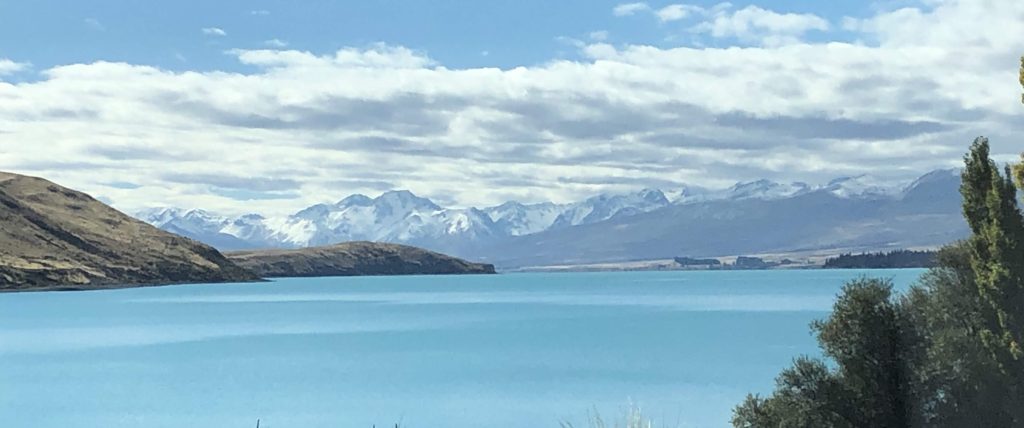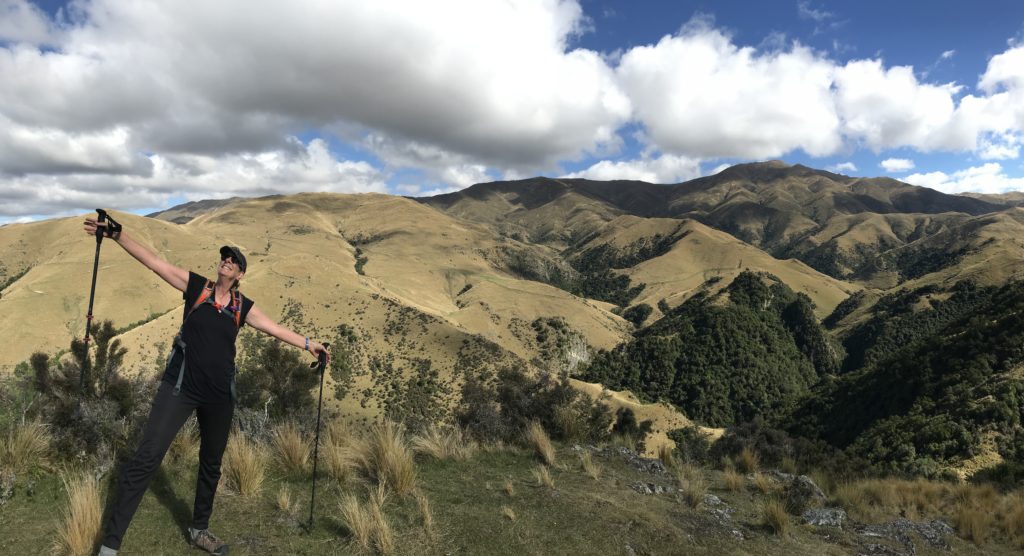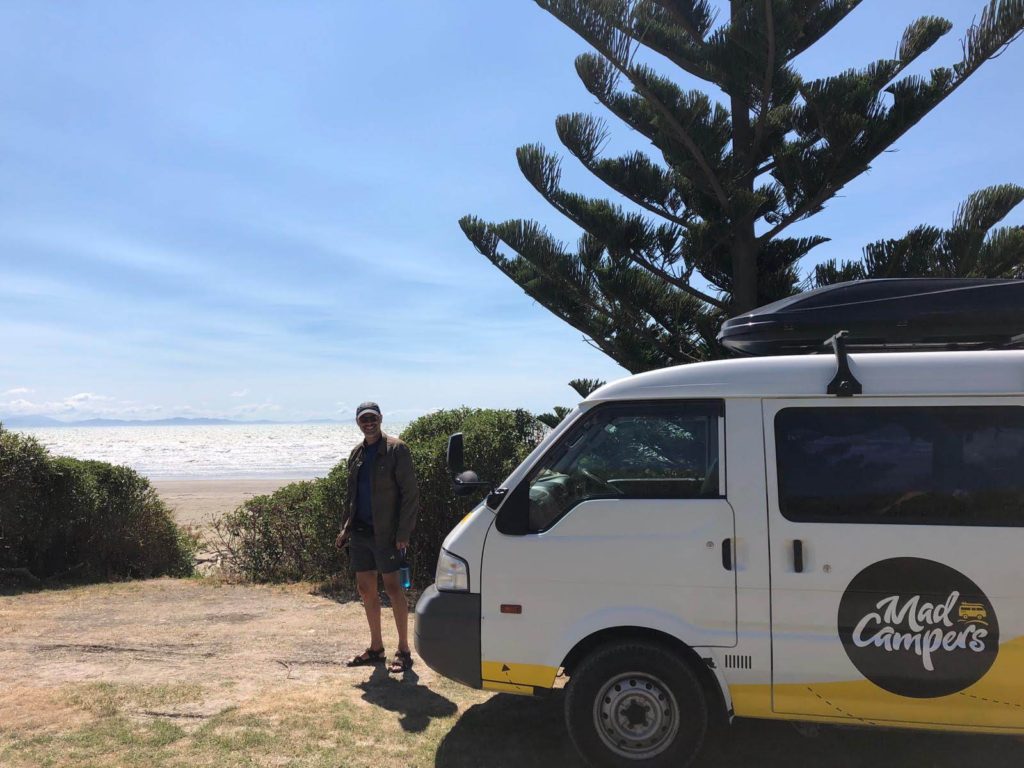We’ve been in New Zealand since January 16 and are leaving tomorrow. A wistful feeling has descended upon us…of wanting to savor every moment, every vista. In our three months here, we’ve learned a lot about the country, or at least about its landscapes and how to get around and see as much as possible. Admittedly, our mode of travel here has positioned us more as camper vagabonds than pseudo-citizens or students of local culture. While we definitely have gotten a feeling for the people, culture, and history of New Zealand and how they compare with the US, I’m reluctant to assert any sweeping conclusions here.
Instead, we’ve been reveling in this country’s big and varied natural landscapes, areas of remote wildness, varied coastlines, bucolic pastures, and rolling vineyards. We’ve seen coastal beach bum towns, mountaineering hubs, small traditional farming and fishing communities, and stunning waterways of almost unbelievable colors.
To come close to New Zealand’s wild nature, there’s no better method than to camp your way through. We have had some amazing campsites: steps from the sea, on the shores of a glistening lake or remote bay, and nestled in mountain valleys. Many of the places had few or no other lodging options. Camping allowed us to stay in isolated natural places that we just couldn’t access otherwise.
I know camping is not for everyone, and I tend toward the evangelist on this matter. But please bear with me!
When I started writing this blog, I was sitting outside our campervan at Pioneer Park, a rustic Department of Conservation (DOC) campsite, feeling the warmth of the morning sun on my face, savoring my first coffee, and listening to a nearby chorus of bird song and the distant roar of rutting deer.

International tourism to New Zealand has risen steadily over the past 20 years. In 2000, NZ welcomed 5.75 million international tourists; by January 2019 there were 14 million. The bigest increase has come in the last five years. That’s a lot of tourists for a country of 4.5 million people. Many come by cruise ship, dropping in at Auckland, Wellington, Christchurch (Akaroa), or other port city. Driving New Zealand’s roads, you can’t help but be struck by how many tourists are exploring the country in campervans of all shapes and sizes.
We spent just two weeks touring the North Island (see our first blog on New Zealand). The rest of the time we toured around the wilder, less populated South Island—with a few bonus gorgeous days on Stewart Island, off the south end of the South Island. All told, we have spent about sixty nights camping in New Zealand, which has given us quite a range of experiences.
Kiwi Camping: Two Thumbs Up
We had no idea what it would be like to camp in New Zealand. But we decided to give it a go, packing up our tent and a few basic camping supplies in our checked baggage.
We tent camped for our first month here, then rented AirBnB houses for two-plus weeks with our friends Donna, Helen, and Marty. For the last 38 days, we’ve been traveling and sleeping in a small “Mad Camper” campervan that we affectionately called “our little tin can.” As a comparison, the campervan cost US$115/day versus US$65/day for the compact rental car we rented for our first month.
Whether sleeping in our tent or our little tin can, we have found New Zealand to be a very easy place to camp—perhaps the easiest we’ve ever experienced! Here’s why:
- Tourism is such a big part of the economy, and a good portion of it is campervan travel. Most New Zealand towns work hard to make it a smooth and pleasant experience. For example, virtually every town has very clean, free public bathrooms. And even the tiniest towns have an information center (“i-site”) offering local maps, brochures, tips, WiFi, and free booking services. We felt welcomed and well cared for.
- There are a lot of campgrounds, both public (DOC) and private. Most are exceptionally clean and tidy, and the campers are quiet and well-behaved. We met many friendly Kiwis, and foreigners (mostly from the UK, Europe, US, or Canada). Campground set-ups range from just an open field with portajohns and nonpotable water, to others with full kitchens, laundry facilities, a TV lounge, ping-pong table, hot tubs, and trampolines.
- There are two great free apps—Campermate and Rankers—to help you locate campgrounds, know exactly what facilities are offered, and read user reviews. These apps also map gas stations, grocery stores, public toilets, and more, and the info is available offline—helpful when traversing through the many no cell service areas of the country. We heard it’s good to have both apps, as they have slightly different information, but we’ve been happy with Campermate. If you’re even thinking about camping in New Zealand, download Campermate to get an idea of where the campgrounds are located, what they cost, and what you’ll find there. As an aside, fuel is expensive in New Zealand—expect to pay about US$6 for a gallon of gasoline.
- Traveling in New Zealand can be expensive. But campsite prices are not too bad, ranging from free to US$37/night for a site with no electric hookup. A free campsite is of course very basic; it may be no more than a spot in a gravel parking lot or a field. (More on “freedom camping” below.) We only spent one night in a free campsite, preferring instead to pay for a few extras. We stayed in several DOC campsites (US$11/night for two people) located in attractive natural settings, with clean toilets and running water. Sometimes we had to pay an extra dollar for a hot shower and another dollar for WiFi access. It was all well worth it!
- Campgrounds with full communal kitchens and lounge areas are common, which make it really easy to camp! I don’t recall ever staying at a US campground with kitchen facilities. In New Zealand, they are fairly common. Private campgrounds with extensive facilities are generally called “holiday parks.” A common holiday park kitchen offers several stove tops and sinks; even some higher-end DOC campgrounds and huts have these. Often you find other luxuries like an oven, refrigerator, microwave, boiling water dispenser, pots and pans, plates and utensils. Before staying in one of these campgrounds, I recoiled at the idea of using a communal kitchen. I imagined the worst unaccountable “group house” experience where nobody cleans up. I wasn’t sure if I could even bring myself to go in. But I’ve been pleasantly surprised. We have now stayed in more than 10 of these higher-end campgrounds, and all had spotless kitchens. (If there are recent reviews on Campermate complaining of dirty kitchens or toilets, we won’t go, period.) Though our campervan was fine for cooking and washing up, it’s much more enjoyable to cook in a real kitchen, especially if the weather is bad. The communal cooking scene can also be a great venue for meeting people and comparing travel notes. Only one time did we experience a kitchen that was frighteningly crowded.
Freedom Camping
We had never traveled in a campervan before. But my research suggested that renting a “certified self-contained” campervan—a vehicle with some kind of toilet and a system for collecting and disposing of grey water—would open up a wide range of free camping opportunities. I thought we’d be able to stay for free in natural places all over New Zealand that are not accessible to tent campers—who don’t have a “certified self-contained” vehicle.
According to the official New Zealand freedom camping website, “freedom camping is when you camp on public land that isn’t a recognised camping ground.” There are multiple websites that depict idyllic freedom camping in amazing locations all over New Zealand. Who doesn’t love freedom? I was so excited!
Of course the reality is much more nuanced.
While it may have been so in the past, you can’t just camp wherever you like today. If you camp in the wrong place, you could face a significant fine. This was a bit nerve-wracking because it wasn’t always clear to us where freedom camping was allowed. Each town council sets its own rules, and ignorance of the law is no excuse…. We were told that we should assume it is always forbidden except where expressly permitted, with signage.
Some towns have had bad experiences with freedom campers and have banned freedom camping on public lands. Those towns that do allow it usually only offer a small parking lot. Free campsites can be mobbed with far more campervans than “allowed,” especially those in scenic places. Sometimes a local official monitors the campsite to make sure the rules are followed, and sometimes not. And “freedom” can mean you’re free to box in other vans, but not free from being boxed in. It’s a libertarian, egalitarian system that can foster great inequality.

We didn’t want to drive a large motorhome, so we rented one of the smallest campervans available. We loved our little tin can…but we didn’t love the toilet that came with it to qualify as “self-contained.” It’s a small portable unit, only slightly more elaborate than the potty our kids used when toilet training. Waste must be emptied at a dump station, and our campervan company provided detailed video and written instructions for using, emptying, and cleaning the toilet. Even Bob, who has a long-standing professional interest in latrines and toilets, found this idea less than appealing. We never ended up using the toilet as a toilet! Instead, since there wasn’t a lot of room in our campervan, we used the closed lid of the toilet as a sort of night stand. Fortunately, as noted above, it is easy to find clean public toilets, as well as campgrounds with excellent bathroom facilities. So we avoided camping in places with no bathrooms, which generally meant staying in a paid campground.

Our van’s water system, on the other hand, was useful. We had a 25-liter fresh water tank and faucet into a small sink, so water was readily available for drinking, cooking, and washing up. The sink drained to another 25-liter tank that captured the grey water. Every week or so we emptied the grey water at a dump station, which are provided at virtually every town and holiday park.

While freedom camping didn’t live up to our fantasies, we’re still glad that we ended our New Zealand summer camping in a campervan instead of tenting. By mid-March, we started to get a bit more rain, wind, and cold weather, including a few nights that were near freezing. We were warm and cozy sleeping in the van. We also had a canopy that created a small extra room on the back of the van, offering protection from the elements on those evenings when we used our van kitchen.
Traveling Light
International camping means traveling light. I actually enjoy the minimalist approach, as I crave connection to the natural world. Camping takes me there, and minimizes the distractions of material things. I like to think these experiences have reset my being in a positive way.
We travel with only what can fit into one checked bag per person, under the weight limit, to avoid paying excess baggage charges. We pack all of our clothes and personal items in a large backpack suitable for multi-day hikes. When we fly, we put our backpacks and camping gear in two large duffel bags, and we carry a daypack as carry-on luggage. The duffel helps to keep our backpack straps away from airline bag handling machinery. The loaded duffels may be under the weight limit, but they’re still heavy and clumsy; Bob can carry his, but I can’t carry mine. So we get a luggage cart at the airport, or he helps me. (Thanks Bob!)
Packing for a Kiwi Camping Adventure
For those interested in the details, here is a suggested packing list for a New Zealand camping holiday for two:
- Small tent—ours is a two-person backpacking tent, and all we do in it is sleep.
- Sleep system—whatever works for you. We love ours.
- Small cook stove for those times when you don’t have access to a kitchen. Buy your fuel here.
- Basic cooking and dining supplies. We have a pot, a metal salad bowl, small cutting board, sharp knife, a wooden spoon, 2 small metal all-purpose bowls, 2 spoons and 2 forks, and 2 all-purpose cups (good for coffee, tea, and wine!).
- A simple lightweight coffee making system like this one
- Small ziplock bags of herbs and spices, salt and pepper. Why should your camp food be boring?!
- Small cooler or insulated bag (these can be purchased here)
- A few reusable shopping bags (no paper or plastic shopping bags here!)
- Dish soap, sponge and dish towel. A tablecloth if you want to get fancy!
- Headlamps and a small lantern (we love our solar-powered Luci)
- Some lightweight rope for a clothesline and clothespins
- Small camp chairs (if you have room)
- Personal toiletries and clothes (layers!), rain coat, rain pants, swimwear, a towel, etc. It’s a very casual place, so you don’t need anything fancy. I’m always surprised by how few items of clothing I actually need.
What an excellent adventure we’ve had! And we dressed stylishly all the while, even when there was nobody watching. Whether you’ve got two weeks or three months to spend, we give Kiwi camping two thumbs up.


















Great stories and tips. Thanks and safe travels back to the USA. Lovely to connect here in NZ
Fantastic! I hope to be able to use your advice someday in NZ.
Thanks Dierdre! I hope you can do it—I think you would enjoy it!
WOW, what an adventure and seeing the wilderness which we never got to. Your photos are beautiful. So glad that yo enjoyed it so much. Enjoy Hawaii. Love you guys,
Thanks Mom!! It’s been so great! Xoxox!!
You crazy kids!!! Enjoy! The closest I like to get to nature is my beautiful back yard…
A beautiful backyard is a great gift! Enjoy!!
Hey Ramón! Your beautiful backyard is part of nature; stop tending it for a few months or a year and you’ll see how quickly nature takes charge! Cheers, my friend.